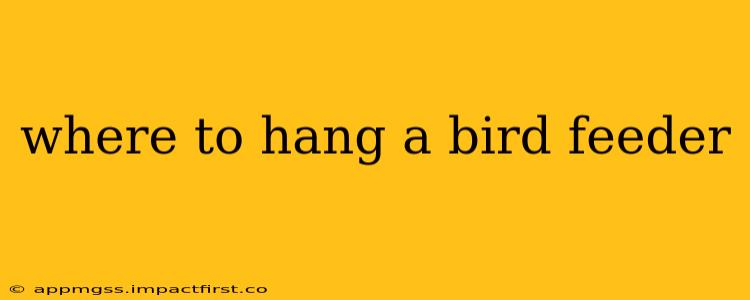Attracting feathered friends to your backyard is a rewarding experience. But simply putting up a bird feeder isn't enough; placement is crucial for maximizing bird activity and ensuring their safety. This guide will cover the ideal locations and considerations for hanging your bird feeder, answering many common questions about bird feeder placement.
How High Should a Bird Feeder Be?
The ideal height for your bird feeder is a balance between providing a safe distance from predators and offering easy access for birds. Generally, placing your feeder between 4 and 6 feet off the ground is a good starting point. This height is high enough to deter many ground predators like cats and raccoons, yet low enough for smaller birds to easily reach. However, you may need to adjust based on your specific circumstances and the predominant bird species in your area.
What is the Best Location for a Bird Feeder?
The best location offers a clear view of the surrounding area, allowing birds to spot approaching predators. Consider these factors:
- Visibility: Choose a spot where birds can easily see approaching cats, hawks, or other threats. Avoid placing the feeder near dense shrubs or bushes that could provide cover for predators.
- Shelter from the elements: While visibility is key, you also want to protect the feeder and its contents from harsh weather. A location offering some shade from direct sun and rain is ideal. Consider overhanging branches or the shade of a building.
- Accessibility for birds: Place the feeder near natural perches like trees or shrubs, allowing birds to land safely before approaching the feeder.
- Distance from windows: Place the feeder at least 10 feet away from windows to prevent collisions. Birds, especially during feeding frenzies, may not see glass windows.
- Proximity to water sources: Birds need a water source for drinking and bathing. Consider placing a bird bath nearby for added attraction.
What Should I Avoid When Placing a Bird Feeder?
- Areas with high foot traffic: Avoid placing the feeder near heavily trafficked areas where people or pets may disturb the birds.
- Underneath power lines: This is a significant safety hazard for both birds and yourself.
- Areas with overgrown vegetation: Dense vegetation offers hiding places for predators and makes it difficult for birds to spot threats.
Where Should I Not Put a Bird Feeder?
You should avoid placing feeders:
- Directly below branches: This can create a convenient spot for predators to ambush the birds.
- Too close to ground-level vegetation: This provides cover for predators like cats.
- In areas that are exposed to strong winds: Strong winds can make feeding difficult and may even damage the feeder.
How Do I Keep Squirrels Away From My Bird Feeder?
Squirrels are notorious for raiding bird feeders. Consider these strategies:
- Squirrel-resistant feeders: These feeders are designed with features that make it difficult for squirrels to access the food.
- Changing feeder locations: Regularly changing the location of your feeder can sometimes deter persistent squirrels.
- Use of deterrents: There are commercially available squirrel deterrents that can help.
How Often Should I Clean My Bird Feeder?
Regular cleaning is essential to prevent the spread of disease among the birds. Clean your feeder at least once a month, or more frequently during warm, humid weather. Use a mild soap solution and thoroughly rinse before refilling.
By carefully considering these factors, you can create a bird-friendly environment that attracts a variety of species to your backyard, providing hours of enjoyable birdwatching. Remember, observation and adjustment are key – see which locations work best for your local birds and adjust accordingly!
